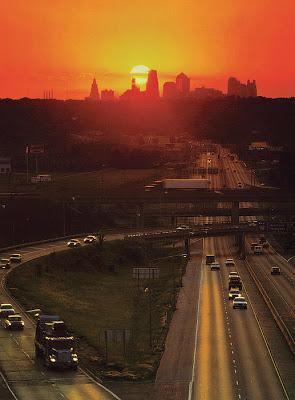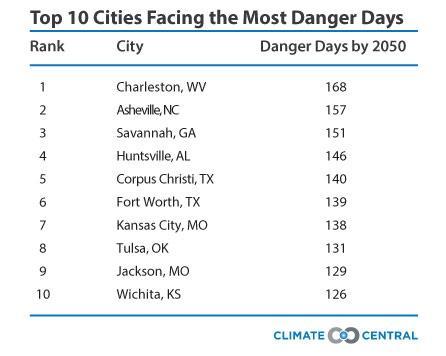With the warming of the planet, proven, scientifically, it becomes important to know what's in front of us.
There's a rather important article out last month from the online environmental magazine Grist:

Top 10 cities facing the most “danger days” due to climate change
So what is a "danger day"?
A danger day is when the combination of heat and humidity (also known as the heat index) make it feel like it’s 105 degrees F or hotter. Warming temperatures are about to push U.S. cities into a new regime where danger days happen regularly.
With the globe's warming temperatures, it's projected we will continue to have ever-climbing temperatures.
Of the 144 U.S. cities Climate Central analyzed, only 12 of them averaged more than one danger day per year since 1950. Most of those cities are clustered in the South where humidity tends to be worst in the morning while temperatures peak in the late afternoon.
But by 2030, a whopping 85 cities — home to nearly third of the U.S. population — are projected to deal with at least 20 danger days annually. Only nine cities are projected to experience less than one danger day per year. By 2050, just three cities could have as little as one danger day per year, while 109 cities that are home to 125 million Americans will experience 20 danger days or greater annually.
So where does this tend to look likely to hit worst? Where, in the nation, will be most heated and have the most of these "danger days"? Here are the top 10 cities projected now. And look who's right about in the middle of it all:

There is a lot of the Midwest there. Tulsa, Oklahoma, Jackson, Missouri, Wichita, Kansas all along with our own Kansas City.
Some of the ripple effects?
All that added heat will change the daily rhythm of life across the U.S. The impact on health will be a top concern, particularly for children and senior citizens. When the heat index rises above 105°F, heat exhaustion can set in and cause fainting, dizziness, confusion and vomiting. When humidity crosses 60 percent, the body also loses its ability to cool itself by sweating. Hot, humid conditions have made high school football a focal point for heat exhaustion as heat-related deaths have tripled since 1994.
Some states and cities have responded by setting up rules to cancel sports practices based on the weather forecasts while others have cooling centers and warning systems to help deal with oppressive conditions. Rising temperatures mean those plans will have to be adjusted and relied upon more regularly.
Outdoor laborers will see their productivity fall. According to findings in the Risky Business report, the productivity of farmers, construction workers, landscapers, and others who work outside could drop by 3 percent by century’s end.
It will also drive up how much people spend on energy as air conditioning goes from being handy to being a necessity. If greenhouse gas emissions continue on their current trend, energy expenditures could rise by up to 7 percent by 2050 and 21 percent by 2100. That added capacity will strain the electricity grid, and even violent crime could rise.
Once again, it doesn't look pretty, ladies and gentlemen.
It would be nice if our legislators---all of them---would start taking action on climate change. Heaven knows some in the business community and the lots of the military, both, already have.
